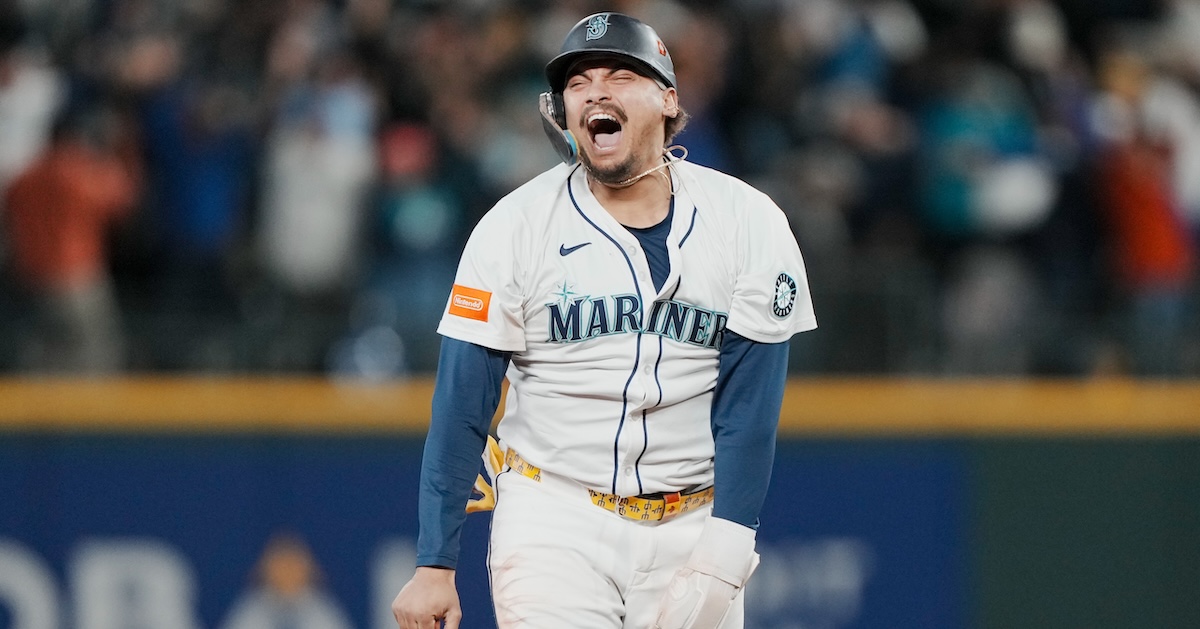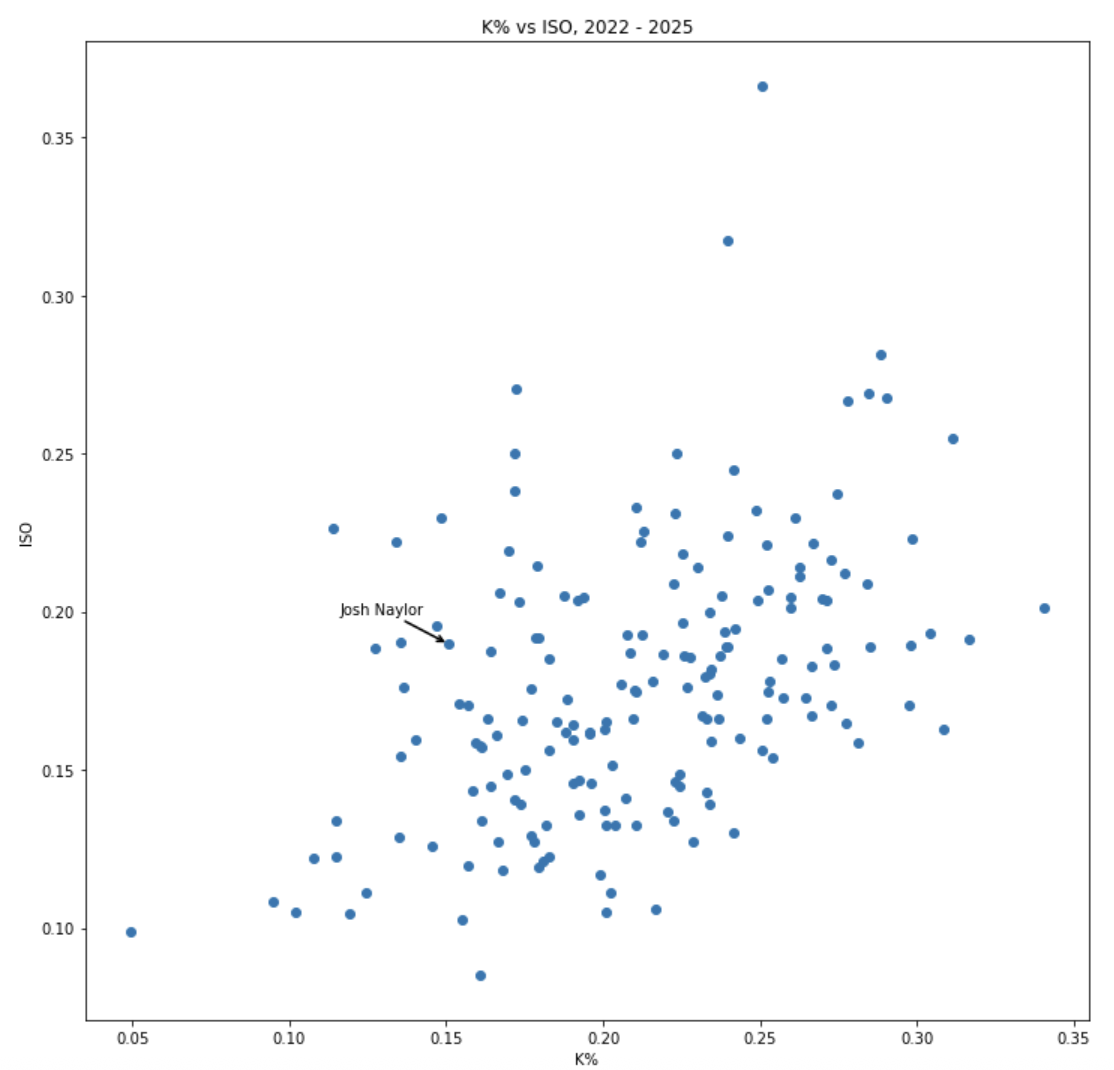Josh Naylor Reunites With Seattle on a Five-Year Deal

Technically, the starting gun for the 2025-26 offseason already fired. Back on November 5, Leody Taveras signed a one-year, $2.1 million contract with the Orioles, though you’d be forgiven for missing that news, seeing as it came just days after a transcendent World Series and didn’t even merit a writeup on this august website. So let us consider November 16 the official first day of the offseason. On Sunday evening, Jeff Passan reported that first baseman Josh Naylor and the Seattle Mariners were “finalizing” a five-year deal. (On Monday evening, Ken Rosenthal reported the terms: five years, $92.5 million.) In estimating Naylor’s contract for our annual Top 50 Free Agent ranking (he checked in at no. 11), Ben Clemens anticipated a four-year, $100 million deal, while the median crowdsource projection was four years and $80 million.
The first real move of the offseason, fittingly, is perhaps its most predictable. From the day their season ended, the Mariners’ front office shared its desire to bring Naylor back to the Pacific Northwest.
“It was a great fit and it’s definitely a priority for us this offseason — if not one, I don’t know what else would be, he’s no. 1 right now,” Mariners general manager Justin Hollander told MLB Network Radio on the first day that free agents were allowed to sign with other teams. “I don’t really see a reason, there’s no advantage to hiding the ball, to telling people, ‘It was just fine.’ It wasn’t just fine. It was awesome. It was a great fit for the two months, and we’d like to make it last a lot longer.”
That’s pretty unambiguous, and the clear fit for both sides, as well as the mutual good feelings between player and team, led most analysts to project Naylor’s return. Three out of four MLB Trade Rumors writers predicted Naylor would sign with Seattle, while Passan picked Naylor as the Mariners’ “perfect transaction” in his Monday column.
It’s not difficult to understand the team’s desire for a stable solution at first base. Prior to the 2024 and 2025 trade deadlines, the Mariners’ production from the position was subpar enough to merit acquiring a rental to cover the last two months of the season, with Naylor brought this year and Justin Turner the year before. Indeed, apart from two and half good years from Ty France, Seattle has cycled through guy after guy at first base for the better part of a decade. (Adam Lind! Ryon Healy! Danny Valencia! Donovan Solano! Rowdy Tellez!) And strong internal solutions weren’t on offer; the Mariners dealt their best first base prospect (Tyler Locklear) to the Diamondbacks in the July Eugenio Suárez deal, so if they stayed within the organization, the team would’ve been banking on Luke Raley to cover the bulk of plate appearances at the position.
And who better than Naylor, who put together a magical run after arriving in Seattle from Arizona. He put up a 137 wRC+ in his 54 regular season games with the Mariners and supplemented that batting line with one of the wildest baserunning hot streaks in recent memory, swiping 19 bags in spite of his third-percentile sprint speed. He somehow leveled up in the playoffs, delivering a .967 OPS and countless clutch hits when major parts of the lineup were otherwise flailing.
This is FanGraphs, but it must be said that the intangible elements of Naylor’s presence on the club almost certainly played a part in the front office’s enthusiastic desire for a reunion. When asked on Saturday who he’d deem MVP of the clubhouse, Cal Raleigh named Naylor. The erstwhile Diamondback played (and cheered on the team) with an intense, palpable energy, and appeared to form close personal connections with many of the team’s core players, including Tucker, the Mariners’ clubhouse dog.
While Naylor’s connection with Tucker is heartwarming, it probably wasn’t sufficient to merit a deal that approached nine figures. Helpfully, the signing also manages to make good baseball sense. Between Raleigh, Randy Arozarena, and (until this season) Julio Rodríguez, the offensive core of the club features a healthy amount of swing-and-miss. Naylor’s high-contact approach lends balance to a lineup that has suffered through spells of being overly reliant on the long ball. Since he started earning regular playing time in 2022, Naylor’s 15.1% strikeout rate ranks among the stingiest in baseball; his 13.7% K rate in 2025 sat in the 91st percentile. And unlike most other low strikeout hitters, Naylor can launch a tank every now and again. While it’s hard to see him matching his 31-homer peak from 2024, there’s enough pop in the bat to boost his isolated slugging to respectable levels, rounding out his offensive game:

Mariners president of baseball operations Jerry Dipoto has, in his now decade-plus tenure at the helm of the franchise, stayed away from lucrative deals for free agent hitters. Mitch Garver’s two-year, $24 million contract was the richest he’d given to a hitter since he landed in Seattle. (That didn’t go so great.) But one could see why it’s easier to get behind a five-year deal for a guy like Naylor. He won’t turn 29 until next June, meaning the majority of the contract will unfold within his relative physical prime. (As recent research by former FanGraphs contributor Justin Choi shows, bat speed tends to start its graceful decline around a hitter’s age-32 campaign, though more on that in a minute.)
While Mariners fans, the front office, and presumably Naylor himself all appear enthusiastic about the reunion, the deal is not without its potential downsides. Generally, players receiving five-year deals are closer to the star end of the spectrum than Naylor, whose 3.1 WAR last season was a career high. Steamer projects him for 2.4 WAR in 2026; ZIPS is a bit more optimistic, forecasting 3 WAR and a .784 OPS:
| Year | BA | OBP | SLG | AB | R | H | 2B | 3B | HR | RBI | BB | SO | SB | OPS+ | WAR |
|---|---|---|---|---|---|---|---|---|---|---|---|---|---|---|---|
| 2026 | .272 | .334 | .450 | 529 | 67 | 144 | 31 | 0 | 21 | 91 | 48 | 82 | 18 | 125 | 3.0 |
| 2027 | .266 | .328 | .437 | 519 | 64 | 138 | 29 | 0 | 20 | 87 | 47 | 80 | 16 | 120 | 2.5 |
| 2028 | .262 | .326 | .426 | 500 | 60 | 131 | 28 | 0 | 18 | 81 | 46 | 77 | 14 | 116 | 2.1 |
| 2029 | .255 | .318 | .409 | 479 | 55 | 122 | 26 | 0 | 16 | 74 | 43 | 75 | 12 | 109 | 1.6 |
| 2030 | .252 | .315 | .399 | 449 | 50 | 113 | 24 | 0 | 14 | 67 | 40 | 71 | 10 | 106 | 1.2 |
One could perhaps add that a man of Naylor’s physique is not necessarily the one you’d want to bet on to age the most gracefully, though it does appear he’s slimmed down since his days in Cleveland. And it is hard to see a world where Naylor pops a six-win season; in all likelihood, he’s pretty well locked into the “above-average regular” tier of player with a low probability of garnering MVP votes.
Another potential element of concern is Naylor’s bat speed decline. His average swing speed went from 72.9 mph in 2024 to 70.9 mph in 2025, the largest drop-off of any qualified hitter. As Jay Jaffe argued in October, however, that drop may have been part of an intentional “power for contact” tradeoff on Naylor’s part; those slower swings helped him increase his squared-up rate by nearly four percentage points and his batting average from .243 to .295.
Ultimately, “above-average regular” is what the Mariners are paying and hoping for from this signing. In terms of star-level hitters, they are well-covered: Rodríguez and Raleigh are two of the best in the sport, and Arozarena — the weird shape of his production aside — slots in well as a third banana.
With Cole Young ready to assume a regular big league role, Colt Emerson waiting in the wings, and J.P. Crawford on the final year of his deal, the Mariners aren’t likely to sign a middle infielder. And with roughly $35 million to spend on free agents this winter, and the third base job the only clear place still in need of an upgrade on the offensive side of the ball, the team was always likely to spend some cash for a first baseman. As long as Naylor can hold down the cold corner while delivering his yearly 120 wRC+ and acting like a benevolent maniac for the next three years or so, the Mariners will be satisfied customers.
Michael Rosen is a transportation researcher and the author of pitchplots.substack.com. He can be found on Twitter at @bymichaelrosen.

Love the write up – just want to mention that the dollar value of the deal is not included in this article.
Yes, the first paragraph said that the final dollar value hasn’t been publicly released yet.
I think you misspelled “Now says,” mate.
No worries, though.
92 mil. full no-trade clause. KInda team friendly.
Yep – I like it a lot for both sides.
Glad they’ve been updating the article (at least twice, by this point!).
Also, apparently no deferrals.